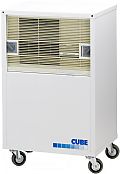
| ||||
| |
| |
| |
| |
| |
| |
| |
| |
| |
| |
| |
| |
W. Tombling Ltd.
Wembley House
Dozens Bank
West Pinchbeck
Spalding
Lincolnshire
PE11 3ND
U.K.


You are here:- home > cooling index > evaporative cooling homepage > evaporative cooling equipment
Evaporative cooling equipment
Evaporative cooling equipment costs upto 50% less to purchase than an equivalent air conditioning unit and costs upto 75% less to run.
Such large savings mean evaporative cooling equipment is frequently installed purely on cost grounds, without fully considering its advantages and disadvantages, resulting in some uncomfortable working environments and evaporative cooling gaining a bad reputation.
To create a comfortable working environment using evaporative cooling, it is necessary to appreciate the differences between air conditioning and evaporative cooling equipment.
Evaporative coolers and air conditioners are different!
Evaporative cooling and air conditioning reduce the air temperature in different ways:
Air conditioning is best suited to cooling small to medium sealed spaces; because it works by continually recirculating and cooling the air inside the room. For maximum efficiency doors and windows must be kept closed.
Air conditioning is unaffected by outdoor conditions, it will circulate cold air continuously irrespective of the outdoor temperature and humidity level.
Evaporative cooling is best suited to medium to large open space areas with good ventilation and air movement. It can be used in small rooms and offices but adequate ventilation must be provided, either by opening doors and windows, or fitting mechanical supply fans.
The efficiency of evaporative cooling systems depend on the humidity of the incoming air. On muggy days, the cooling effect is reduced, and in very humid conditions, it can make the workplace more uncomfortable. Luckily such days are quite rare, but when they do occur, evaporative coolers should be operated without cooling to provide air movement.
The disadvantages of evaporative cooling equipment
The single biggest disadvantage of evaporative cooling equipment is its dependence on a constant supply of fresh air. Without it, the air in the room becomes damp, the cooling effect decreases and eventually stops completely.
Evaporative coolers should be positioned near to a convenient open door or window. Where this is not possible supply fans must be installed to deliver fresh air into the building.
Alternatively evaporative coolers can be installed outdoors (preferably in the shade), using flexible ducting to deliver the cooled air into the workplace.
The advantages of evaporative cooling equipment
Evaporative coolers work most efficiently when drawing fresh air from outdoors. This offers several major benefits over refrigerated air conditioners, which recirculate the same stale dry air over and over.
Constant cool air movement pushes heat out - along with stale air, smoke, odours and pollution.
Constant supply of fresh moist air. Evaporative cooling does not dry out the air like refrigerated air conditioning. Maintaining natural humidity levels prevents:
Flowers, furniture, fabrics and foodstuffs from drying out.
Static electricity from building up.
Complaints from workers about sore throats, dry eyes and running noses.
Environmentally friendly, energy efficient cooling for the workplace
Evaporative cooling is environmentally friendly and energy efficient. It delivers superior air quality because it draws fresh air into the building, and helps businesses to reduce their CO2, CFC and other greenhouse gas emissions.
Evaporative cooling systems are a viable alternative to refrigerated air conditioning, especially in commercial buildings such as factories, workshops and warehouses; where it will deliver high volumes of fresh cool air at a fraction of the cost of traditional air conditioning.
You are here:- home > cooling index > evaporative cooling homepage > evaporative cooling equipment
If you found this page useful, please take a moment
to tell a friend or colleague about it.
Copyright © 2004/6, W. Tombling Ltd.